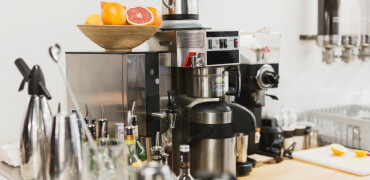Here's the problem; you've run out of space. And if you haven't, you probably will. Photos and videos are all space-hoggers, and as everything from magazines to music goes digital, we're all going to need more and more storage. Thing is, there's an awful lot of storage options out there, and not all of them have the explanations written on the box. Before we go in-depth on each type, lets have a quick run through of the different terms you may come across.
KB, MB, GB, and TB
That's a whole lot of letters which may well make absolutely no sense, but it's important you completely understand what they mean before you go HDD hunting. First of all, we've got KB, or kilobyte. This is probably the smallest unit you'll have to deal with in computing, and while there are smaller units out there, there's too many to go into. After KB we've got MB, short for megabyte. A megabyte is 1024 kilobytes, and your average photo can be anywhere between 3 and 7 megabytes. A song can also be around that size, depending on the quality, while a dvd is usually around 700 MBs.
Next in size we've got GB, or gigabytes. When it comes to HDDs, this is the most common unit you'll be looking at, so it's important to get a grasp on what it is. Not that it's particularly difficult - a gigabyte is 1024 megabytes. So if you do a bit of math there, you'll find that, on average, you can fit around 200 photos per gigabyte, or close to that same amount of songs. Coming after gigabytes we've got TB, or terabytes, and yep, you guessed it - a terabyte is 1024 gigabytes. More math brings us to the conclusion that we can fit around 210,000 pictures - a fair amount more than a gigabyte, that's for sure. Easy, right?
External HDDs
External HDDs, External Hard Disk Drives, or more commonly known as simply Portable Hard Drives, are the easiest way of adding a bit of extra space to your computer. Coming in all sorts of digital sizes, these plug-and-play solutions can store anything digital you could think of, and make fantastic back-up solutions for your PC. There are two options when it comes to getting a portable hard drive - USB powered or wall powered.
The USB powered option plugs directly into your computers USB port, and that's it. No extra cables, which means no mess. These are ideal for tourists, students, and anyone wanting a bit of extra space for the road. Often the USB powered options are a touch more expensive than their alternatives, and often aren't quite as fast as the bigger, wall-powered options. If you're in need of something lightweight and ultra-portable, then it may be just what you're after.
If you don't mind a few extra cables, and need a larger storage capacity, then the wall powered options should be right up your alley. Not only are they physically bigger, they also tend to come in larger digital sizes, up to around the 2 TB mark. They're also often faster at transferring data to and from a computer as well, although it's not always the case. The downside to these wall powered ones is fairly self explanatory - they need to be plugged into a wall socket. Not only does this mean extra cables, it also means that you can't access the data unless you're near a wall socket, which can be a huge hassle, especially for travellers.
NAS HDDs
More letters, but don't worry. NAS HDD's are Network Attached Storage Hard Disk Drives. That's a huge long name for something fairly straightforward. NAS hard drives are only really suitable if you've got a network set up in your home, or are planning on setting one up in the near future. Unlike portable hard drives, which can only be plugged into one PC at a time, NAS's can be connected to a network and be accessed by all the computers on said network. Also unlike portable hard drives, the speed of an NAS is dependant on your network speed, and therefore usually lower than a normal portable hard drive, around 11 to 100 MBps (Megabytes per second). If what I'm saying makes zero sense to you whatsoever, chances are you're not in the market for one. On the other hand, if you need some extra storage for your network but either can't afford or can't be bothered setting up a server, then an NAS HDD may be just what you're after.
IDE and SATA HDDs
IDE, or Integrated Drive Electronics, and SATA, which is short for Serial Advanced Technology Attachment, are two internal types of hard drive. As opposed to the external counterparts we've been talking about earlier, these two species are internals, meaning they have to be installed on your PC. The differences between the two are fairly simple, with IDE being an older, somewhat outdated model, and SATA being "the way of the future", so to speak. SATA is faster, has the ability to "hot-swap" meaning you can plug the new hard drive in without having to worry about changing BIOS (it all gets rather complicated), and is easier to install. Some people have recorded issues with installing older operating systems, such as Windows 98, on the newer SATA hard drives, although as most modern computers are running Windows 7 or Vista, it shouldn't pose a problem for anyone. It boils down to this - If you've got an old machine, it probably has an IDE drive in it. Newer machines have SATA drives, in general. Check your PCs compatibility before buying either of these, as they're not always cross-compatible.
SAS and SCSI HDDs
SCSI, also known as Small Computer System Interface, and SAS, short for Serial Attached SCSI, are two types of server drives. A server is basically a collection of HDDs all linked together to provide storage for more than one computer. Servers are mainly used for companies and offices who require constant access to large amounts of data, but they can be set up by anyone who knows how, and are used more and more for home use. A server is designed to be run constantly, and are often performing heavy duty tasks that would be too strenuous for your run-of-the-mill PC. SCSI, and the newer, faster SAS hard drives are server HDDs, and as such may seem to cost a lot more than you'd expect to pay. For instance, a 2 TB portable HDD could cost you around $180. A 300 GB SAS drive, on the other hand, could set you back anywhere from $400 to $1200. Why such a price jump?
Well, as I said, server drives are supposed to be running 24/7, and can be accessed by multiple computers at once. Because of that, they need to not only be faster, but also be far more hard wearing. Where an average HDD will run at around 7200RPM, a server HDD can run around 15000RPM. RPM is basically the speed of an HDD, and while 7200RPM is enough for a home PC, it's nowhere near enough to be accessed by 5 or more PCs at the same time, for hours on end.
The differences between SCSI and SAS drives are fairly minor - SAS is newer, and therefore better in more than one ways. It's faster, can have more devices connected to it, and is harder wearing. You'll find that most server drives on the market at the moment are SAS, since SCSI is getting on in life.
SSD
SSDs, short for Solid State Drives, are the definite way of the future. Unlike standard HDDs, SSDs have no moving parts, and because of that are insanely fast, and generate no heat. If you install an SSD into your PC and install the operating system on it, you could, depending on the rest of your PC, have a start-up time of less than 20 seconds. On top of that, there's no heat factor involved, since the lack of moving parts means there is nothing to generate that heat. The lack of heat also means that they're a lot longer lasting - the estimated "survival time" of a few SSDs we've seen is over 100 years of non-stop running.
SSD hybrids are on the rise as well, and are often cheaper then bog standard SSDs, but don't perform quite as well. In saying that, you may want to go for a hybrid, since all these benefits don't come cheap. A 40 GB SSD could set you back $300, but it's well worth the investment. If you're building a PC, and want to prepare for the future, then SSD is definitely the way to go.
So which brand?
There are many good brands when it comes to hard drives, but there are a few that stand out. Iomega offers a few fantastic wall powered portable options, and Seagate is well worth a look at as well. HP has a few out there which offer instant backup solutions, but can often be a bit pricier than their alternatives - you pay for the extra features, whether you want them or not. Seagate is two of the best internal HDD manufacturers, and have a huge range of products available, with different speeds, sizes, and performance levels.
Final checklist
To help make things even easier, we've done up a quick list to help you find exactly which kind of HDD you're looking for;
- USB powered portable HDD - Perfect for travelers, students, and anyone else needing extra storage without having to sacrifice portability.
- Wall powered portable HDD - Ideal for someone looking to permanently expand their computers storage capacity, without having to go through the hassle of opening the computer and fit an internal one themselves.
- NAS HDD - Great for anyone with a network set up in their home or small office. It'll add that extra space you need, and it's perfect for getting all your photos, movies, and music in one spot to be accessed by your whole house.
- SATA and IDE HDD- Sata is perfect for anyone building a computer themselves, or just looking to upgrade the internal capacity of their PC. IDE is good for people with older machines that still support the format, but not recommended for anyone with a computer only a few years old.
- SAS and SCSI HDD - Ideal for server upgrades. If you aren't completely sure with all the details of one of these, chances are you're not in need of one. These are suitable mainly for people in the IT business who upgrade other peoples servers, or those with enough knowledge to attempt upgrading their own.
- SSD HDD - A must have for anyone building their own PC, or anyone who just wants to future-proof their current computer. SSD will probably become industry standard in the next few years, as more and more manufacturers start using this fantastic technology in their machines.




